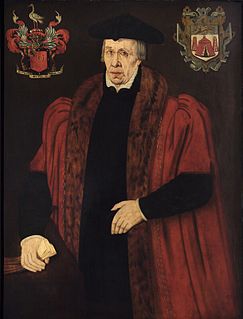
William II Canynges (c. 1399–1474) was an English merchant and shipper from Bristol, one of the wealthiest private citizens of his day and an occasional royal financier. He served as Mayor of Bristol five times and as MP for Bristol thrice. He was a generous patron of the arts in Bristol, particularly concerning the church of St Mary Redcliffe in Bristol, "The crown of Bristol architecture". Following the death of his wife Joan in 1467, he renounced civic and commercial life and was ordained a priest in 1468, in which capacity he remained until his death six years later. His tomb effigy in St Mary's later inspired the boy poet Thomas Chatterton to write the romantic poem "The Storie of William Canynge".
Sir William Laxton was a Lord Mayor of London during the reign of Henry VIII, and eight times Master of the Worshipful Company of Grocers. He is the founder of Oundle School.
Sir Thomas Myddelton was a Welsh merchant who was Lord Mayor of London before becoming a Member of Parliament for London.

Sir Thomas White was an English cloth merchant, Lord Mayor of London in 1553, and a civic benefactor and founder of St John's College, Oxford.
George Monoux, born in Walthamstow, Essex, England, was an English merchant in Bristol and London. Six times Master of the Worshipful Company of Drapers, he served as Lord Mayor of London and was an important benefactor in Walthamstow. He was a descendant of John Monoux of Stanford, Worcestershire.
Sir John Norreys was a high ranking Lancastrian, and the head of the branch of the Norreys family who became prominent under the reign of the House of Tudor. He served as Keeper of the Wardrobe for King Henry VI of England.

Sir Thomas Knollys or Knolles was an English businessman in London who was active in both local and national government.
Sir Nicholas Brembre was a wealthy magnate and a chief ally of King Richard II in 14th-century England. He was Lord Mayor of London in 1377, and again from 1383–5. Named a "worthie and puissant man of the city" by Richard Grafton, he became a citizen and grocer of London, and in 1372-3 purchased from the Malmains family the estates of Mereworth, Maplescomb, and West Peckham, in Kent. His ties to Richard ultimately resulted in his downfall, as the anti-Richard Lords Appellant effectively took control of the government and imprisoned, exiled, or executed most of Richard's court. Despite Richard's efforts, Brembre was executed in 1388 for treason at the behest of the Lords Appellant.

John Seymour of Stapleford in Wilton, Wiltshire, and of Wulfhall in Savernake Forest, Wiltshire was an English landowner and Member of Parliament.
Sir Thomas Lodge, was Lord Mayor of London.
Sir John Frederick was an English merchant, MP and Lord Mayor of London.
Sir John Gore was an English merchant who was Lord Mayor of London in 1624.
William Sevenoke was a grocer and politician who served as Mayor of London in 1418, and as warden of London Bridge, alderman of Bishopsgate Ward, alderman of Tower Ward, Warden of the Grocers' Company, Sheriff of London, Member of Parliament for the City of London and Surveyor of the King's works at Isleworth.
Sir Thomas Offley was a Sheriff of London and Lord Mayor of London during the reign of Queen Mary I of England. A long-serving alderman of London, he was a prominent member of the Worshipful Company of Merchant Taylors, thrice Mayor of the Staple, and a named founding Assistant of the Muscovy Company.
Hugh Fenn, also written Fenne or atte Fenn, was an English official from Norfolk who rose to a high position in the Exchequer during the reigns of King Henry VI and Edward IV.
William Cromer was an English Sheriff and Lord Mayor of London and a Member of Parliament for the city.
Canynges is a surname. Notable people with the surname include:
Sir John White or Whyte of Aldershot and London was Lord Mayor of London 1563-64. He was knighted by Elizabeth I in 1564. He lived during the reigns of Henry VIII, Edward VI, Lady Jane Grey, Mary I, and Elizabeth I.
Nicholas Wotton was an English merchant and official who twice served as Lord Mayor of London, in 1415 and 1430.




